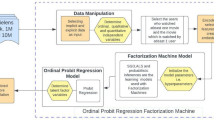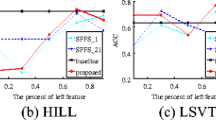Abstract
Ordinal regression (OR) or classification is a machine learning paradigm for ordinal labels. To date, there have been a variety of methods proposed including kernel based and neural network based methods with significant performance. However, existing OR methods rarely consider latent structures of given data, particularly the interaction among covariates, thus losing interpretability to some extent. To compensate this, in this paper, we present a new OR method: ordinal factorization machine with hierarchical sparsity (OFMHS), which combines factorization machine and hierarchical sparsity together to explore the hierarchical structure behind the input variables. For the sake of optimization, we formulate OFMHS as a convex optimization problem and solve it by adopting the efficient alternating directions method of multipliers (ADMM) algorithm. Experimental results on synthetic and real datasets demonstrate the superiority of our method in both performance and significant variable selection.
Similar content being viewed by others
References
Liu T Y. Learning to rank for information retrieval. Foundations and Trends in Information Retrieval, 2009, 3(3): 225–331
Lee S K, Cho Y H, Kim S H. Collaborative filtering with ordinal scalebased implicit ratings for mobile music recommendations. Information Sciences, 2010, 180(11): 2142–2155
Kim M, Pavlovic V. Structured output ordinal regression for dynamic facial emotion intensity prediction. In: Proceedings of European Conference on Computer Vision. 2010, 649–662
Rudovic O, Pavlovic V, Pantic M. Multi-output laplacian dynamic ordinal regression for facial expression recognition and intensity estimation. In: Proceedings of the the 2012 IEEE Conference on Computer Vision and Pattern Recognition. 2012, 2634–2641
Kramer S, Widmer G, Pfahringer B, De Groeve M. Prediction of ordinal classes using regression trees. Fundamenta Informaticae, 2001, 14(1–2): 1–13
Kotsiantis S, Pintelas P. A cost sensitive technique for ordinal classification problems. In: Proceedings of the Hellenic Conference on Artificial Intelligence. 2004, 220–229
Lin H T, Li L. Reduction from cost-sensitive ordinal ranking to weighted binary classification. Neural Computation, 2012, 24(5): 1329–1367
Waegeman W, Boullart L. An ensemble of weighted support vector machines for ordinal regression. Transactions on Engineering, Computing and Technology, 2006, 12(3): 71–75
Chang K Y, Chen C S, Hung Y P. Ordinal hyperplanes ranker with cost sensitivities for age estimation. In: Proceedings of the 2011 IEEE Conference on Computer Vision and Pattern Recognition. 2011, 585–592
Chu W, Keerthi S. Support vector ordinal regression. Neural Computation, 2007, 19(3): 792–815
Sun B Y, Li J, Wu Dash D, Zhang X M, Li W B. Kernel discriminant learning for ordinal regression. IEEE Transactions on Knowledge and Data Engineering, 2010, 22(6): 906–910
Chu W, Ghahramani Z. Gaussian processes for ordinal regression. Journal of Machine Learning Research, 2005, 6(7): 1019–1041
Duda R, Hart P, Stork D. Pattern Classification. John Wiley & Sons, 2012
Rendle S. Factorization machines. In: Proceedings of the 10th International Conference on Data Mining. 2010, 995–1000
Yamada M, Lian W, Goyal A, Chen J, Wimalawarne K, Khan S, Kaski S, Mamitsuka H, Chang Y. Convex factorization machine for regression. 2015, arXiv preprint arXiv:1507.01073
Blondel M, Fujino A, Ueda N. Convex factorization machines. In: Proceedings of the Joint European Conference on Machine Learning and Knowledge Discovery in Databases. 2015, 19–35
Fukunaga K. Introduction to Statistical Pattern Recognition. Elsevier, 2013
Bien J, Taylor J, Tibshirani R. A lasso for hierarchical interactions. Annals of Statistics, 2012, 41(3): 1111–1141
Yan X, Bien J. Hierarchical sparse modeling: a choice of two regularizers. 2015, arXiv preprint arXiv:1512.01631
Yuan M, Joseph V R, Zou H. Structured variable selection and estimation. The Annals of Applied Statistics, 2009, 3(4): 1738–1757
Haris A, Witten D, Simon N. Convex modeling of interactions with strong heredity. Journal of Computational and Graphical Statistics, 2016, 25(4): 981–1004
Zhao P, Rocha G, Yu B. The composite absolute penalties family for grouped and hierarchical variable selection. Annals of Statistics, 2009, 37(6A): 3468–3497
Radchenko P, James G M. Variable selection using adaptive nonlinear interaction structures in high dimensions. Journal of the American Statistical Association, 2011, 105(492): 1541–1553
Boyd S, Parikh N, Chu E, Peleato B, Eckstein J. Distributed optimization and statistical learning via the alternating direction method of multipliers. Foundations and Trends® in Machine Learning, 2011, 3(1): 1–122
Blondel M, Fujino A, Ueda N, Ishihata M. Higher-order factorization machines. In: Proceedings of the 30th International Conference on Neural Information Processing Systems, 2016, 3359–3368
Blondel M, Ishihata M, Fujino A, Ueda N. Polynomial networks and factorization machines: new insights and efficient training algorithms. In: Proceedings of the International Conference on Machine Learning. 2016, 850–858
Jacob L, Obozinski G, Vert J P. Group lasso with overlap and graph lasso. In: Proceedings of the 26th International Conference on Machine Learning. 2009, 433–440
She Y, Wang Z, Jiang H. Group regularized estimation under structural hierarchy. Journal of the American Statistical Association, 2018, 113(521): 445–454
Lim M, Hastie T. Learning interactions via hierarchical group-lasso regularization. Journal of Computational and Graphical Statistics, 2015, 24(3): 627–654
Bach F, Jenatton R, Mairal J, Obozinski G. Structured sparsity through convex optimization. Statistical Science, 2012, 27(4): 450–468
Beck A, Teboulle M. A fast iterative shrinkage-thresholding algorithm for linear inverse problems. SIAM Journal on Imaging Sciences, 2009, 2(1): 183–202
Lu C, Zhu C, Xu C, Yan S, Lin Z. Generalized singular value thresholding. In: Proceedings of the 29th AAAI Conference on Artificial Intelligence. 2015, 1805–1811
Cai J F, Candès E J, Shen Z. A singular value thresholding algorithm for matrix completion. SIAM Journal on Optimization, 2010, 20(4): 1956–1982
Gutierrez P, Perezortiz M, Sanchezmonedero J, Fernandeznavarro F, Hervasmartinez C. Ordinal regression methods: survey and experimental study. IEEE Transactions on Knowledge and Data Engineering, 2016, 28(1): 127–146
Xu B, Bu J, Chen C, Cai D. An exploration of improving collaborative recommender systems via user-item subgroups. In: Proceedings of the International Conference on World Wide Web. 2012, 21–30
Rendle S. Factorization machines with libFM. ACM Transactions on Intelligent Systems and Technology (TIST), 2012, 3(3): 57
Rhee S Y, Taylor J, Wadhera G, Benhur A, Brutlag D L, Shafer R W. Genotypic predictors of human immunodeficiency virus type 1 drug resistance. Proceedings of the National Academy of Sciences, 2006, 103(46): 17355–17360
Kang Z, Peng C, Cheng Q. Robust PCA via nonconvex rank approximation. In: Proceedings of the International Conference on Data Mining (ICDM). 2015, 211–220
Acknowledgements
This work was partially supported by the National Natural Science Foundation of China (Grant Nos. 61472186, 61702273) and the Natural Science Foundation of Jiangsu Province (BK20170956).
Author information
Authors and Affiliations
Corresponding author
Additional information
Shaocheng Guo received his BS degree and master degree in computer science from Nanjing University of Aeronautics & Astronautics (NUAA), China in 2015 and 2018, respectively. His research interest is machine learning.
Songcan Chen received the BS degree from Hangzhou University (now merged into Zhejiang University), the MS degree from Shanghai Jiao Tong University and the PhD degree from Nanjing University of Aeronautics and Astronautics (NUAA), China in 1983, 1985, and 1997, respectively. He joined in NUAA in 1986, and since 1998, he has been a full-time professor with the Department of Computer Science and Engineering. He has authored/co-authored over 170 scientific peer-reviewed papers and ever obtained Honorable Mentions of 2006, 2007 and 2010 Best Paper Awards of Pattern Recognition Journal, respectively. His current research interests include pattern recognition, machine learning, and neural computing.
Qing Tian received his PhD degree in computer science from Nanjing University of Aeronautics and Astronautics, China in 2016. He is currently an assistant professor in the School of Computer and Software, Nanjing University of Information Science and Technology, China and is currently visiting, as an academic visitor, at the University of Manchester, UK. He is the recipient of the ICPR Best Scientific Paper Awardin 2016, the Excellent Doctoral Disser-tation Award of Jiangsu Province of China in 2017, etc. His research interests include machine learning and pattern recognition, especially in the areas of ordinal regression and metric learning and its applications.
Electronic supplementary material
Rights and permissions
About this article
Cite this article
Guo, S., Chen, S. & Tian, Q. Ordinal factorization machine with hierarchical sparsity. Front. Comput. Sci. 14, 67–83 (2020). https://doi.org/10.1007/s11704-019-7290-6
Received:
Accepted:
Published:
Issue Date:
DOI: https://doi.org/10.1007/s11704-019-7290-6




